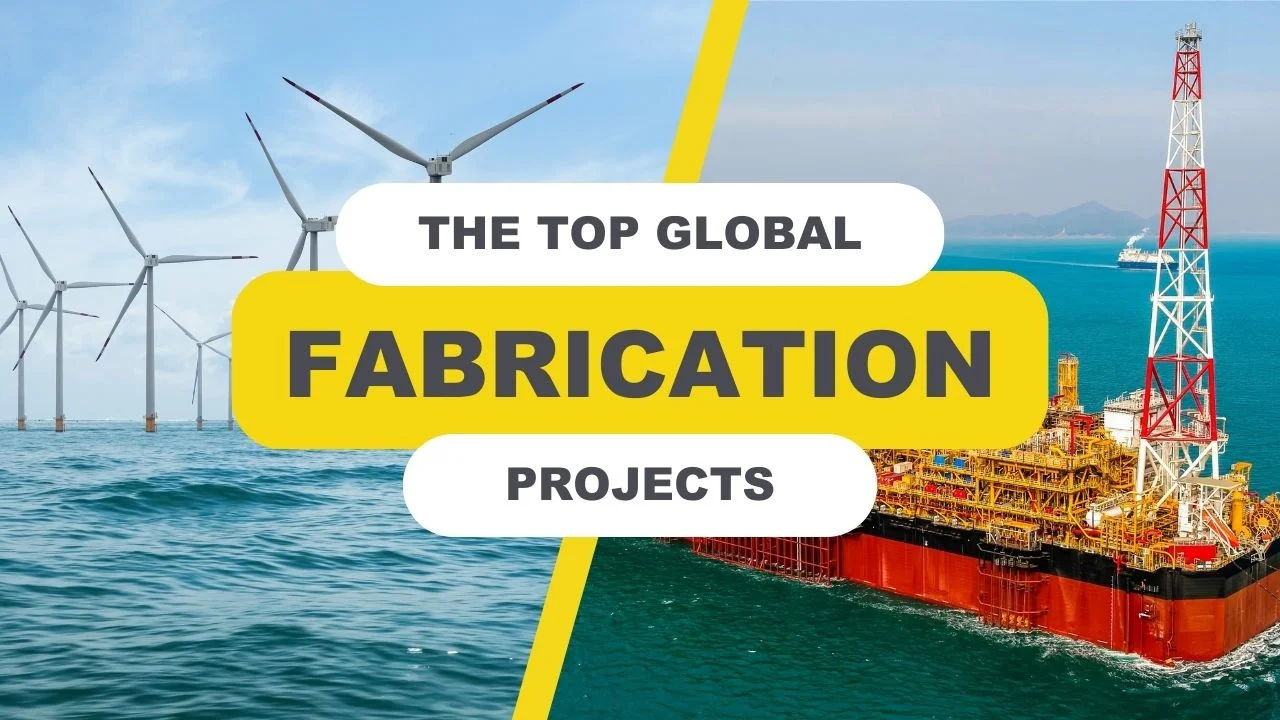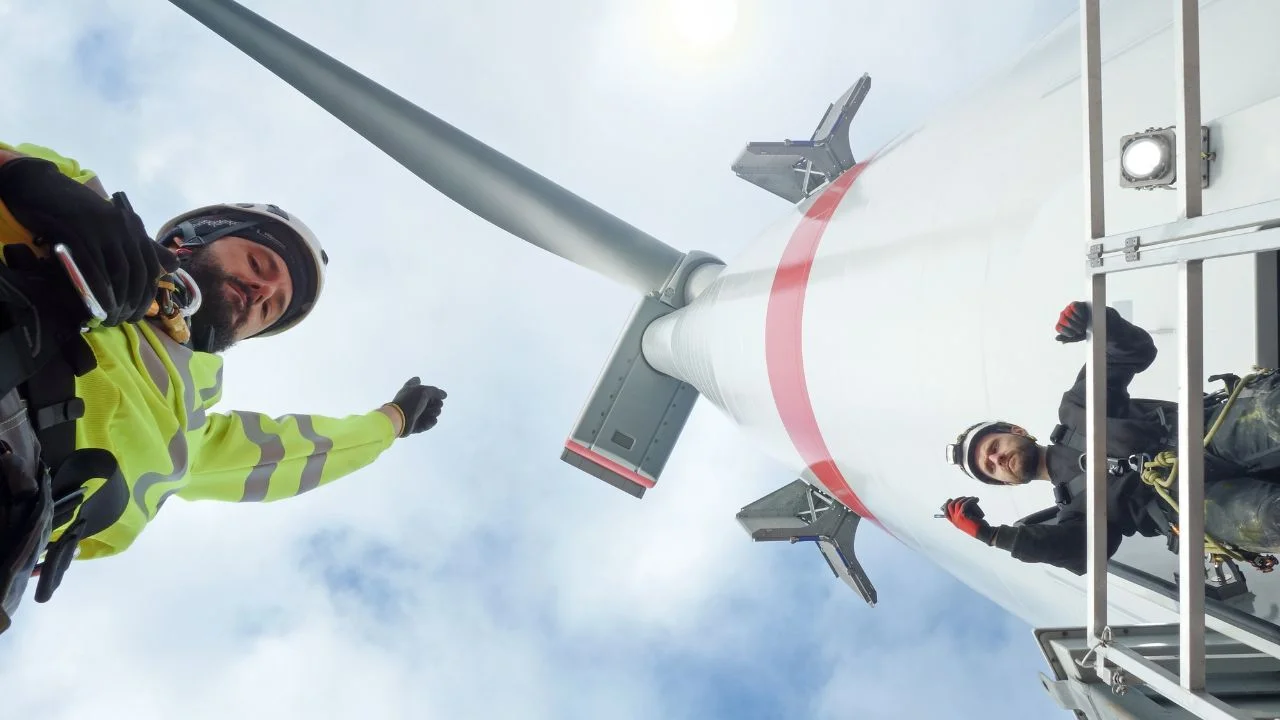Top Fabrication Projects Supporting Global Renewables and Oil & Gas Growth
26 Nov, 202515:44Key Takeaways: Fabrication yards and shipyards in China, Singapore, Batam, Thailand, an...

Key Takeaways:
- Fabrication yards and shipyards in China, Singapore, Batam, Thailand, and Vietnam are critical to delivering today’s largest renewables and oil & gas projects.
- Global offshore wind farms rely on European and Asian markets for foundation fabrication capacity for XXL monopiles, jackets, and substation manufacture.
- Guyana, Suriname, Nigeria, and Brazil FPSO/Gas projects illustrate how oil & gas is still a dominating sector in fabrication demand.
- Skilled labour shortages in welding, pipefitting, NDT, commissioning, and high-demand disciplines such as QA/QC inspection, topside module fabrication, and electrical/instrumentation supervision remain the biggest risk to delivery schedules.
- Clients who engage early on talent forecasting, global mobility, and specialist recruitment partnerships are best positioned to avoid fabrication bottlenecks.
Fabrication yards are now essential to renewable energy and oil & gas megaprojects as global energy demands evolve. From offshore wind farms in Scotland to FPSO developments in Guyana and Brazil, global fabrication and shipyard capacity is under increasing pressure as offshore energy projects scale in complexity and volume, alongside mounting pressure on skilled labour and supply chains.
This blog profiles seven standout developments across renewables and oil & gas, highlighting the key supporting fabrication hubs. It examines the strategic allocation of fabrication scopes and the operational risks of workforce shortages. As delivery schedules tighten, early engagement in talent forecasting and global mobility planning is critical to mitigating fabrication bottlenecks and ensuring project execution.
Which Major Renewables and Oil & Gas Projects Are Currently Driving Global Fabrication and Shipyard Activity?
Inch Cape Offshore Wind Farm – Scotland, UK
- Construction Start: 2025 | Completion: 2026
- Parent Company: Red Rock Power Limited
- Fabrication Locations: Smulders yard (Wallsend, UK), CWHI (Qinzhou, China), Dajin (Penglai, China), COOEC-Fluor (China)
The Inch Cape Offshore Wind Farm is one of Europe’s most significant renewable projects and Scotland’s largest offshore wind development under construction. The farm is designed to generate nearly five terawatt-hours of electricity annually, enough to power half of Scottish homes.
Fabrication is being executed across multiple countries. In the UK, the Smulders yard in Wallsend fabricated and assembled the Siemens Energy Offshore Transformer Module (OTM®), the first ever double-circuit OTM® of its kind. Over 250 specialists worked on the project at Wallsend for over 18 months, supported by 80 local suppliers delivering scaffolding, coatings, engineering, and lifting services.
OES Group has been selected to supply external and internal Impressed Current Cathodic Protection (ICCP) systems for the project’s monopile and transition piece foundations. These ICCP anodes will be manufactured in Gateshead, UK, and shipped to two fabrication yards in China. The yards at Qinzhou and Penglai are rolling out 54 XXL monopiles for the foundation fabrication, stretching 100m in length and weighing more than 2,700 tonnes for the 72 wind turbines. COOEC-Fluor is fabricating 18 jacket foundations, reinforcing China’s dominance in large-scale offshore infrastructure.
Earlier this year, the OTM® substation sailed from Newcastle and was installed offshore by Heerema Marine Contractors using the Sleipnir. As fabrication progresses, monopiles and foundations will continue to arrive at the Port of Leith for installation offshore.
Fengmiao Offshore Wind Farm – Taiwan
- Phase I Construction Start: 2025 | Completion: 2027
- Phase II: Early-stage development, capacity beyond 2027
- Parent Company: Copenhagen Infrastructure Partners (CIP)
- Fabrication Locations: PTSC M&C yard (Vũng Tàu, Vietnam), SK Oceanplant (Goseong, South Korea)
The Fengmiao Offshore Wind Farm is a notable renewable energy project in Taiwan, designed to deliver long-term stability. Awarded under Taiwan’s Round 3.2 Zonal Development Offshore Wind Auction, Fengmiao is being developed by CIP through its CI V fund, with its sister company, Copenhagen Offshore Partners (COP), leading development activities.
Phase I, with 496 MW capacity, reached financial close and began construction in 2025. Earlier this year, construction of the onshore substation (OSS) commenced, which will connect to Taipower’s Zhongqing substation, marking a major milestone in Taiwan’s renewable infrastructure. The EPC contract for the offshore substation was awarded to Semco Maritime and PTSC M&C, with fabrication taking place at PTSC M&C’s yard in Vũng Tàu City, Vietnam. SK Oceanplant has also been contracted to fabricate jacket foundations at its yard in Goseong, South Korea.
Phase II is in its early stages but will expand the total Fengmiao capacity to 1.8GW, reinforcing Taiwan’s offshore wind leadership. The project will involve the installation of 33 XXL jackets topped with 15MW turbines.
Once complete, the project will contribute significantly to Taiwan’s Round 3 offshore wind programme, which totals 6.3GW and is expected to power more than 7 million homes while cultivating local talent for the offshore wind industry.
Baltica Offshore Wind Farm – Poland
- Baltica 2 Construction Start: 2025 | Completion: 2027
- Baltica 3: Development ongoing, completion by 2030
- Parent Company: Ørsted and PGE Polska Grupa Energetyczna
- Fabrication Locations: PTSC M&C yard (Vũng Tàu, Vietnam), Gdańsk & Gdynia shipyards (Poland), Sif (Roermond, Netherlands), Smulders (Poland & Hoboken, Belgium)
Baltica, developed by Ørsted and PGE, is Poland’s largest renewable energy project and one of the biggest offshore wind farms worldwide. With a planned capacity of up to 2.5 GW, it will supply clean electricity to more than 4 million Polish households. The project is being built in two phases: Baltica 2, now under construction, will deliver 1.5 GW using 107 Siemens Gamesa turbines, with the Port of Gdańsk serving as the hub for storage, pre-assembly, and offshore installation. Baltica 3 will follow, adding another 1 GW by 2030.
Fabrication for Baltica 2 is both extensive and international, involving a coordinated supply chain across Europe and Asia, forming the backbone of OSS West and OSS East, located 20 km from Choczewo. EEW and Steelwind are delivering 111 monopiles, while Grupa Przemysłowa Baltic and Smulders are producing secondary steel structures domestically. The offshore substation platforms are being delivered through a coordinated international effort. Semco Maritime and PTSC M&C are responsible for engineering, procurement, and fabrication of four 375 MW platforms and support frames at their yard in Vũng Tàu City, Vietnam, with completion expected in 2026. This coordinated effort integrates expertise from across Europe and Asia, ensuring the successful delivery of Baltica.
Whiptail Offshore Development, Jaguar FPSO – Guyana
- Construction Start: 2025 | Completion: 2027
- Parent Company: ExxonMobil Corporation
- Fabrication Locations: Seatrium (Singapore)
In Guyana, ExxonMobil’s Whiptail development represents one of the latest additions to the company’s growing fleet of FSPOs. The ‘Jaguar’ FPSO is the sixth project on the Stabroek block and is expected to add 250,000 barrels per day (bpd) of production capacity, bringing Guyana’s output to 1.3 million bpd by 2027.
Esso Exploration and Production Guyana is executing the project, a joint ownership venture between ExxonMobil Corporation (45%), Hess Guyana Exploration Limited (30%), and CNOOC Petroleum Guyana Limited (25%). SBM Offshore is acting as the EPC contractor and is responsible for the FEED work. They have contracted Seatrium to handle the fabrication and integration of the topsides for the FPSO. The Jaguar FPSO is currently in dry dock at Seatrium’s shipyard in Singapore, where the construction of the topsides is progressing as scheduled.
The project involves fabricating modules, riser balconies, and mooring structures, with integration to follow before the vessel’s deployment to Guyana. The Jaguar is SBM Offshore's fifth FPSO for ExxonMobil in Guyana; their ongoing involvement ensures consistency and technical alignment across ExxonMobil’s regional developments.
Block 58 GranMorgu FPSO – Suriname
- Construction Start: 2024 | Completion: 2028
- Parent Company: TotalEnergies SE
- Fabrication Locations: BOMESC Lingang (Tianjin, China)
Just across the maritime border from Guyana, TotalEnergies SE (50% Owner and Operator) and Apache Corporation (50% Owner) are pursuing Suriname’s most ambitious oil project – the GranMorgu FPSO, designed to produce 220,000 barrels of oil per day from the Sarakara and Krabdagu fields. The vessel, targeting first oil in 2028, has been sustainably designed with an all-electric drive platform, zero routine flaring, and waste heat recovery systems.
SBM Offshore and Technip Energies are executing the construction of the Granmorgu FPSO and are responsible for the full scope of engineering, procurement, construction, and installation. SBM Offshore is delivering the FPSO through its Fast4Ward programme. Overall progress has reached 27%, with fabrication of nine topside modules underway at BOMESC’s Lingang shipyard facility in Tianjin, China, scheduled for delivery by 2027. COSCO has reportedly secured a similar workscope, further expanding China’s role in the project’s execution.
Saipem and TechnipFMC have also been awarded the subsea scope, covering umbilicals, risers, and flowlines to be deployed in water depths of up to 1,000m.
Block H/HI Gas & Condensate Platform – Nigeria
- Construction Start: 2025 | Completion: 2027
- Parent Company: Shell Petroleum Development Company of Nigeria
- Fabrication Locations: COOEC (Tianjin, China)
Nigeria’s HI Field, operated by Shell Petroleum Development Company of Nigeria (60%) and Sunlink Petroleum Nigeria Ltd (40%), is being developed through a gas and condensate project that reflects the dual priorities of energy production and sustainability. The project, located in OML 144 Block in the Niger Delta, will deliver 500 million cubic feet of gas per day to Nigeria LNG’s Train 7 expansion while also exporting up to 70,000 barrels per day of condensate at peak production.
China Offshore Oil Engineering Company (COOEC) is executing fabrication at its Tianjin shipyard, where steel cutting commenced in April 2025. The scope includes a three-level topside module and a four-legged jacket structure, with delivery scheduled for 2026. What sets the project apart is the integration of hybrid renewable energy, a combination of solar and wind, to partially power the facility, reducing emissions from operations, a notable example of modulation in offshore energy systems.
BM-C-33 Raia FPSO – Brazil
- Construction Start: 2025 | Completion: 2028
- Parent Company: Equinor ASA
- Fabrication Locations: Cosco Qidong (China), BOMESC (China), Aibel (Norway), Keppel (Singapore), Rio de Janeiro (Brazil)
Equinor’s BM-C-33 Raia FPSO, located in Brazil’s pre-salt Campos Basin, is one of the most complex floating production projects currently under construction. The FPSO is designed to have a capacity of 126,000bpd and up to 16 million cubic metres of gas, with storage capacity for two million barrels. MODEC is leading the EPCI, applying a new build design for the FPSO, which includes a double hull design. It will employ a fully electrified combined cycle system, significantly reducing its carbon footprint compared to conventional FPSOs. The Raia Manta and Raia Pintada fields developed by Equinor are expected to create up to 50,000 local jobs throughout their lifecycle.
The fabrication scope is distributed across several global hubs. COSCO Shipping Heavy Industry is responsible for constructing hulls and living quarters in China. BOMESC, also in China, is fabricating topside modules, while Aibel in Norway and Keppel in Singapore contribute to the module scope. Repsol Sinopec has announced that the Raia FPSO has moved to the dry dock to the quay 24 days before schedule, and MODEC reached an important milestone regarding the FPSO in March 2025 by completing 1 million work hours without any lost time injuries (LTI) or lost time accidents (LTA).
Integration of the modules with the FPSO hull will be carried out at COSCO Qidong before the final deployment offshore in Brazil. The project’s complexity and multi-region fabrication scope, spanning shipyards in China, Singapore, Norway, and Brazil, underscore the importance of global coordination and modular skid-based engineering.
Workforce Demands in Global Fabrication
What are the risks to project delivery when fabrication partners face workforce constraints?
The growing imbalance between fabrication hubs and project locations is a notable workforce constraint. Many projects in Europe, Africa and South America depend on fabrication executed thousands of miles away in Asia, making timely workforce mobilisation critical. Having the right workforce is crucial to meeting fabrication milestones; otherwise, there’s a risk of delays in downstream installation, commissioning, and ultimately achieving first oil or first power.
Additionally, there’s the broadening of required skillsets. Traditional roles in welding and pipefitting remain valuable, but projects increasingly demand sustainability specialists spanning hybrid energy integration, emissions monitoring, and digital QA/QC. The workforce of the future will be multi-disciplinary, with expertise in modulation and fabrication foundation, companies that anticipate this trend will be better positioned to deliver on time and budget.
Partnering for Fabrication Success
Global fabrication projects demand precise coordination across geographies, disciplines, and timelines. Proactive recruitment, global mobility planning, and specialist technical staffing are critical to project success.
How can project teams align fabrication schedules with workforce availability across multiple regions?
By partnering with a specialist fabrication & shipyard recruitment agency. NES Fircroft supports clients through every phase of fabrication by delivering compliant, scalable workforce solutions tailored to complex project scopes. With over 50 years of industry experience and a large presence across global fabrication yards and shipyards, we offer energy leaders the ability to forecast workforce demand, mobilise technical talent, and de-risk fabrication schedules. Alongside specialist recruitment, we offer:
- Global mobility and Employer of Record (EOR) services to relocate talent compliantly across borders
- In-country legal and compliance support, including visa processing, payroll setup, and tax frameworks
- Contractor onboarding and orientation, covering PPE, accommodation, banking, and cultural integration
- Cost modelling and talent mapping during FEED and pre-FEED phases to inform fabrication strategy
With a presence in over 45 countries and 23 offices across APAC, we’re actively working in every single yard across the region, enabling clients to de-risk schedules and maintain delivery certainty. Contact NES Fircroft today to secure the workforce your fabrication project needs.














